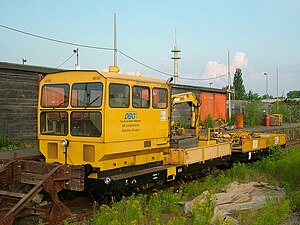DB class Klv 54
| Klv 54 | |
|---|---|
|
Klv 54-0006 of the DBG with trailer Kla 06-0003
|
|
| Numbering: | Klv 54-0001 a Klv 54-0002 – Klv 54-0021 b |
| Number: | 1 + 20 |
| Manufacturer: |
a Union wagon b Schöma |
| Year of construction (s): |
a 1975 b 1979 |
| Axis formula : | B. |
| Gauge : | 1435 mm ( standard gauge ) |
| Length over coupling: |
a 8,500 mm b 8,350 mm |
| Height: | 3,530 mm |
| Width: | 2,990 mm |
| Total wheelbase: | 4,780 mm |
| Payload: | 12.0 t |
| Service mass: | 15.0 t |
| Top speed: | 80 km / h |
| Traction power: | 177 kW (240 PS) |
| Motor type: | 10-cylinder V diesel engine |
| Power transmission: | hydraulic ZF Hydromedia powershift transmission |
| Coupling type: | Truck coupling |
The heavy small car Klv 54 of the German Federal Railways is a secondary vehicle for track construction - and maintenance works.
Development and construction
On the main lines of the German railway network in the 1960s - especially due to electrification - the number of trains increased significantly, while travel speeds continued to rise. In addition, the Deutsche Bundesbahn began planning high-speed routes . In order to maintain these routes , it was necessary to use Rottenkraftwagen that would not significantly hinder regular train operations even on longer journeys . However, the vehicle would not replace the Klv 53 , which is still being delivered , but will only be used on the additional routes.
In 1970, a specification for such a Rottenkraftwagen was drawn up. The BZA Munich and Waggon Union developed the vehicle together. In August 1975 a prototype could be presented, which visually and technically differed significantly from the previous Rottenkraftwagen. As with the Klv 53, there were no regular pulling and pushing devices , but Rockinger couplings and a pile driver to protect the driver's cab, but the vehicle was equipped with a safety driving circuit and Indusi , a compressed air braking system of the standard design and a separate control panel for each direction of travel . In contrast to the foot control of accelerator, brake and (mechanical) clutch in earlier models, the Klv 54 received a throttle lever, driver's brake valve and a diesel-hydraulic drive with electrical direction and gear selection. When the gearbox is switched on, the engine generates a low drag torque when idling, which enables crawling within the construction site. The top speed is 80 km / h and the vehicle is powered by a 10-cylinder V-diesel engine from KHD with a rated output of 177 kW (240 PS).
In addition to the driver, the driver's cab offers space for a further six people and is soundproofed and heated. As with the Klv 53, entry is through a door that can be reached via two steps between the driver's cab and the loading area, both from the side and from the loading area. It is significantly larger than that of the predecessor designs, although the prototype initially only had a circumferential ribbon of windows. Later, a third window was installed below the two existing ones in the front of the vehicle for better observation of the track area directly in front of the vehicle. The vehicle was also equipped with a train radio for communication . As with the Klv 53, the side walls of the driver's cab are drawn in on the vehicle floor to enable long objects to be transported.
There is a loading area behind the driver's cab and an Atlas crane with a loading torque of 100 kNm is installed at the rear . The vehicle weighs 15 t, a payload of 12 t is possible.
Series production
After the prototype had been tested for several years, the Deutsche Bundesbahn ordered a series of 20 vehicles from Schöma , which were delivered in 1979. Technically, these largely corresponded to the prototype, but the front of the vehicle was given a fourth window for better visibility, which leads to the characteristic appearance of this vehicle type.
pendant
As with the previous types of Rottenkraftwagen, trailers that match the Klv 54 were designed and built. Special emphasis was placed on ensuring that sufficient speed could still be achieved with the trailer being pushed. Two types were created: The Kla 06 with a single loading area and 20.4 t payload and the Kla 07 as a two-way tipper with a 16.5 t payload. While the latter only produced the prototype Kla 07-0001 (which was sold to the Karsdorfer Eisenbahngesellschaft together with the Klv 54-0001 in 1998 ), another 20 of the Kla 06 and the Klv 54 were produced. Until the first vehicles were taken out of service, pairs of the same numbered Klv 54 and Kla 06 were used.
commitment

Initially, the vehicles were used exclusively for maintenance and minor renovation work on new and upgraded routes. Since the former in particular have a large proportion of tunnels, some Klv 54s received additional equipment, including a. several work lights, a generator and mobile video surveillance . These vehicles were now listed as type 541, those that were not converted form type 540.
With the merger and closure of many railway maintenance depots since the 1990s and the delivery of new, faster vehicles such as the GAF100 and Robel Bamowag , the Klv 54 lost its traditional area of use. Some vehicles, including the prototype, were sold to private railway companies, others are still used by subsidiaries of DB , such as the Bahnbau Gruppe , on smaller track construction sites.
literature
Joachim Hahn: Track power and road-rail vehicles for the Deutsche Bundesbahn. In: ZEV - Glaser's Annalen. 100 (1976), No. 7/8, ISBN, pp. 240-247.
Web links
- The Klv 54 on eisenbahndienstfahrzeuge.de
- The Klv 54 on Nebenfahrzeuge.de


